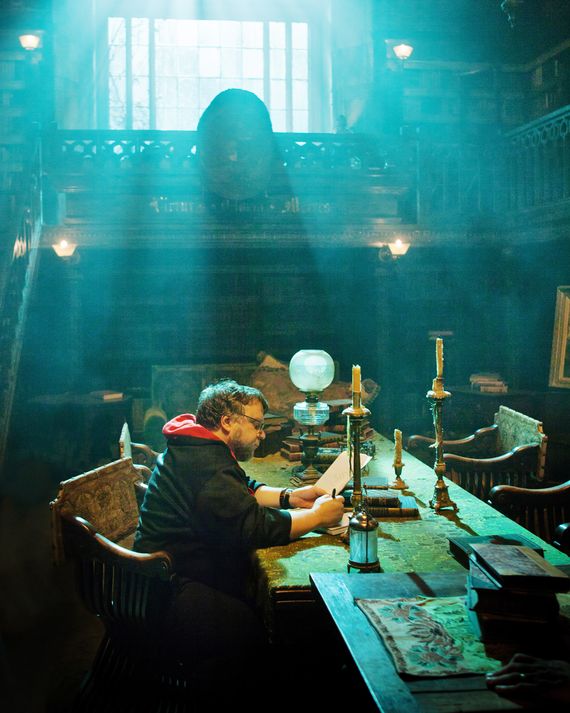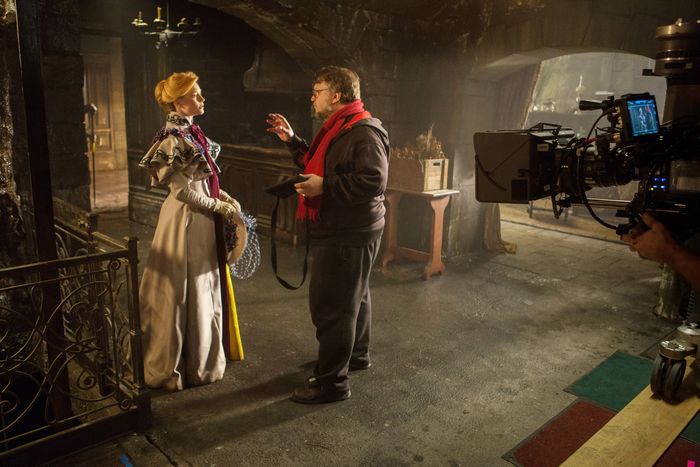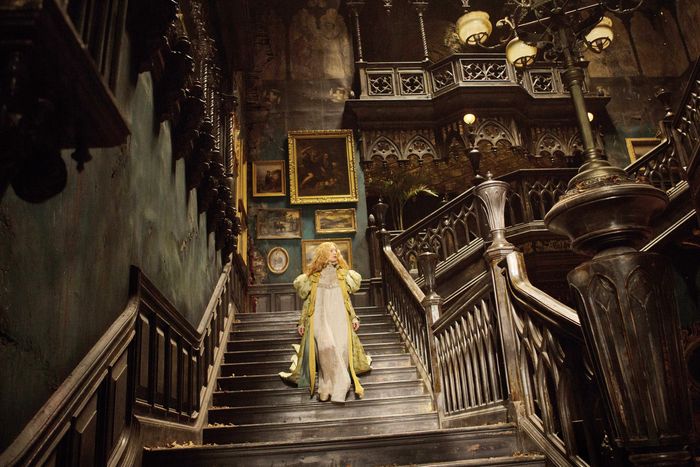
Guillermo del Toro has Gothic in his blood. Ever since he was a boy growing up in Guadalajara, Mexico, the writer-director has been fascinated by Gothic and neo-Gothic literature, film, art, and design. You can see the predilection all through his career, starting with his debut feature, the initially gentle but ultimately disturbing vampire drama Cronos, and continuing through the Spanish Civil War horror films The Devil’s Backbone and Pan’s Labyrinth; the supernatural superhero epics Blade II, Hellboy, and Hellboy II: The Golden Army; his Oscar-winning The Shape of Water (wherein the role of the suffering Byronic lover is played by a fish man); and his stop-motion animated Pinocchio. From the unabashed embrace of melodrama (verging on camp and sometimes crossing over) to the sincere empathy with sensitive but marginalized people and their emotionally malformed antagonists to the maximalist detail in the costumes and sets, del Toro’s sensibility is simultaneously 19th century and 21st.
The most brazenly Gothic del Toro movie of all, and one of his most crushing disappointments in terms of initial reception, was his 2015 romance-horror-fantasy Crimson Peak. Directed by del Toro from his original screenplay, it ticked every box in terms of classic Gothic elements, including an innocent and trusting heroine, a brooding and troubled suitor, a gigantic mansion in a remote area, many dark secrets, and constant intimations of supernatural forces at work. Although it had a gorgeous and appealing cast (including Mia Wasikowska, Tom Hiddleston, Jessica Chastain, and Charlie Hunnam) and got mostly positive reviews, audiences rejected it, in large part because it had been sold as a somewhat straightforward horror movie with a period setting but was actually rather difficult to pigeonhole as any one thing. Like del Toro’s other work, it required surrender to a specific and admittedly peculiar vibe — there was perhaps too much gore for most romance buffs and too much romance for most gore buffs, though it’s hard to say because every unhappy opening-weekend ticket buyer had their own gripe about what they expected but did not get.
What they did get, however, was a feverishly committed movie that wasn’t exactly like anything that had inspired it. The filmmaker’s diverse array of Gothic sources included Wuthering Heights, Northanger Abbey, Uncle Silas, Rebecca, and several of his own movies. Del Toro spoke to Vulture about the alchemy of inspirations that went into Crimson Peak, his lifelong fascination with all things Goth, and his pride and pleasure in watching fans gradually come to consensus about what the movie actually is as opposed to what the advertising told them it was.
Where does Crimson Peak fit into the Gothic tradition?
What I was trying to do with Crimson Peak was what I’ve tried to do in many of my movies: make an action movie that operates as an anti-action movie or, in the case of Crimson Peak, a Gothic romance that defuses the romance — you know, like at the moment when Tom Hiddleston is not revealed to be innocent. He did try to poison her. He did lie to her. He was gonna kill her. But he loves her! He’s not like, “I didn’t do it! I was innocent!” He’s not purged. Mia Wasikowska’s character has fallen in love with him because she doesn’t know him, but then when she knows him, in all his gloriously horrible nature, she still loves him.
With almost ten years distance, how do you feel about the initial reception of Crimson Peak?
The thing that will always, pun intended, haunt that movie is that it was sold as a horror movie. But I remember distinctly, when we had the meetings [about promotion], they were all targeted toward getting the horror audience for the opening weekend. And I knew we were doomed! I was saying, “You should promote the romance, and you should promote the mystery. The last thing you want to do is promote it as horror.” We were opening in October, and October is the month of Halloween, so I understand why it happened.
But, you know, it’s a movie that connects with the people who love it at an almost molecular level. Little by little, some movies gather their audience through the years. Some others are very successful right when they come out, then you don’t hear from them again. We can have every variation. I’m finding that I’m happier when I’m in a relationship with people who truly find a movie and own it.
To be fair to you, though, it’s not like you were doing something totally unprecedented that was beyond anyone’s understanding. Robert Zemeckis’s What Lies Beneath has Gothic elements, and a ghost that not only figures into the plot but intervenes at certain points, and it made $300 million.
There was a resurgence of ghost stories for a couple of decades that was very, very beautiful, with The Others; The Devil’s Backbone, and The Orphanage on my side; the Zemeckis film, and Stir of Echoes, and I thought that was great! But, Crimson Peak … Gothic was, back then, an almost forgotten genre. I don’t know — when was the last time before that had Hollywood produced a Gothic romance? Decades? I knew I wanted to produce a lavish, beautiful, operatic spectacle, with sets and melodrama and beautiful light and, you know, just make it make it a sort of banquet.
And now I’m thinking about seeing Civil War, the Alex Garland movie, getting misinterpreted, even after its characters clearly stated the mission of the movie— “We don’t sanction, we don’t qualify, we just show,” right? That’s basically the definition of Garland’s movie! Well, I tried the same thing in Crimson Peak by having a character actually saying, “It’s not a ghost story, it’s a story with a ghost in it.” The movie itself was trying to give clues about what it was! And, having done a movie before that used a ghost in a similar manner — The Devil’s Backbone — I foolishly thought that my intentions would have been clear.
But you know, it’s okay! You recuperate from it. And that is one of the movies I love the most and that is very close to my heart. Do you remember when we went with the movie to Ebertfest?
Yes! It was a wonderful screening.
You remember what I said on the stage? “This closes the cycle. This is bringing the movie home to an audience that now knows what the movie is.” There are filmmakers I know and admire where you expect that. When a new movie of theirs comes out, it will be different than what you expected, and in time you’ll end up loving it because you now know what it is, and you want to see it again. It’s not a date, it’s going steady with the movie, you know?
When did you start reading Gothic fiction, and what effect did it have on you?
I guess I started reading it really, really early, because some people consider Mary Shelley’s Frankenstein to be Gothic. I would take a little bit of exception to that, but it doesn’t matter. By the time I was 11 or 12, I had already read some of the basics of Gothic fiction. I read Jane Austen right away. I read The Monk, by Matthew Gregory Lewis. I read The Castle of Otranto.
And then, in Mexico, by mere chance, a Spanish and Argentine publisher started republishing all of these popular Ann Radcliffe Gothics, and I got addicted to the sort of askew cemetery poetry of those novels, their exoticism and all the coruscated romances. And then there were all the sub-imitations of Jane Eyre that started invading a very hungry market: you know, Fabio carrying a damsel in distress. But that kind of stuff is not true to gothic romance. It’s just swarthy fantasies, really.
The use of the word “swarthy” is interesting, because so many of these works have a handsome and — in one sense or another — dark stranger who comes into the story and complicates everyone else’s life.
There is always a Byronic, aloof character, from Jane Eyre all the way through to Rebecca. You can track that character, who is haunted by a secret, that is trapped by his wealth and his loneliness and needs to be rescued; and little by little, you uncover the layers. These are variations of the classic Bluebeard fairy tale, with a lot more melodrama. It’s an infallible formula, really. And when it’s great, it’s absolutely great. But what I love most about it are the supernatural elements that underscore a secret from the past coming back. In general, Gothic is a really interesting way to go into the Jungian trappings of the romantic mind, you know?
There are also movies and novels that people know a little less that I also adore, like Uncle Silas, by J. Sheridan Le Fanu, which was adapted into a movie that is now a little harder to get. I consider it one of the great masterpieces. And then you have the streak of Gothic that Daphne du Maurier pursued in all of her short stories, and in her novels.
Du Maurier is fascinating. In works like Rebecca, The Birds, and Don’t Look Now, she brushes up against the supernatural without quite crossing over.
Undoubtedly. In her short stories, there are many more elements that cross into the uncanny, at least. Rebecca is atmospheric and is haunted by an absence, which does not completely qualify it as a Gothic romance, but there are elements of it in the work.
What’s the difference between drama, melodrama, and tragedy?
Here are some definitions I like: In melodrama, most of the time, the characters’ downfalls are caused by their own traits and divisions among them and their interactions with one another. Drama is defined by larger events that are still at a human scale: a disease, war. In tragedy, the mechanism of the downfall is the gods, or destiny.
Can we talk about the houses in Gothic stories? It’s obvious from your films how much you love them.
The houses in the Gothic romance are hugely important, be it Manderley in Rebecca or Cumberland in Crimson Peak. They become characters. And, as I said before, it’s very close to the original model of Bluebeard. A man pulls over and tells a farmer “I’m marrying your daughter,” and he’s a rich guy and he’s handsome and attractive, then he goes into his castle and says, “You can go into all these rooms, except for this one.” There’s always a room with a secret. Those kinds of elements can also end up in a book as dissimilar in appearance as The Secret Garden, you know? The Gothic romance casts a very elongated shadow of influence over many, many books.
It seems like it’s a shape-shifting sort of influence too. My attempts to strictly define Gothic always end in failure.
That’s because it is, in and of itself, a subgenre, one that was birthed out of two very strong genres: the romantic melodrama and the Gothic supernatural drama. It’s an incredibly palatable combination.
On a scale of 1 to 10, how Gothic is your Frankenstein going to be?
I would say pretty Gothic. I would say very high on the scale!
More Goth Excellence
- The Tragic Romance of When the Gargoyles Turned Human for a Night
- Is This Quiz Goth?
- 25 Movies That Define the Goth-Cinema Canon




